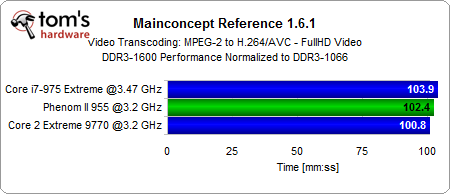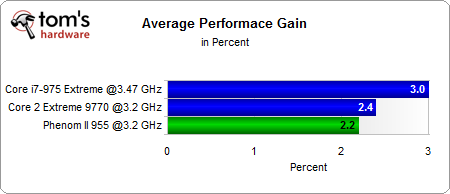Scaling Summary: DDR3 Memory On Core 2, Core i7, And Phenom II
Mainconcept H.264 Encoding
All three platforms benefit from faster DDR3 memory, but the difference is negligible for the Core i7 system.
Adobe Premiere Pro CS4
Video editing using Adobe’s latest Premiere Pro CS4 suite benefits from faster memory on the two Intel systems, but not on AMD’s Phenom II X4. The 6.9% performance increase on the Core i7 system is substantial. Pulling in 6.4% more performance on a fast Core 2 Quad isn’t too shabby, either.
Summary: Average Performance Gain
Overall, we saw some nice performance improvements on all three platforms, but, as expected, some configurations benefitted more from faster DDR3 memory than others.
Overall, it has to be said that single-digit performance gains are typically not worth the additional investment. Our recommendation still stands: mainstream RAM, which today is DDR3-1066 and DDR3-1333, provides sufficient performance. Spending a bit more money on low latency RAM is typically worthwhile, but faster clock speeds are only justified by better overclocking flexibility. If you have more money to spend, look into a faster processor or a solid state drive, or maybe even a beefy graphics card if you’re into gaming. All of these will yield better performance gains for the dollar than top-frequency RAM.
Also check out our three more detailed memory scaling articles:
DDR3 Memory Scaling on AMD’s Phenom II X4
Core i7 Memory Scaling: From DDR3-800 to DDR3-1600
Get Tom's Hardware's best news and in-depth reviews, straight to your inbox.


